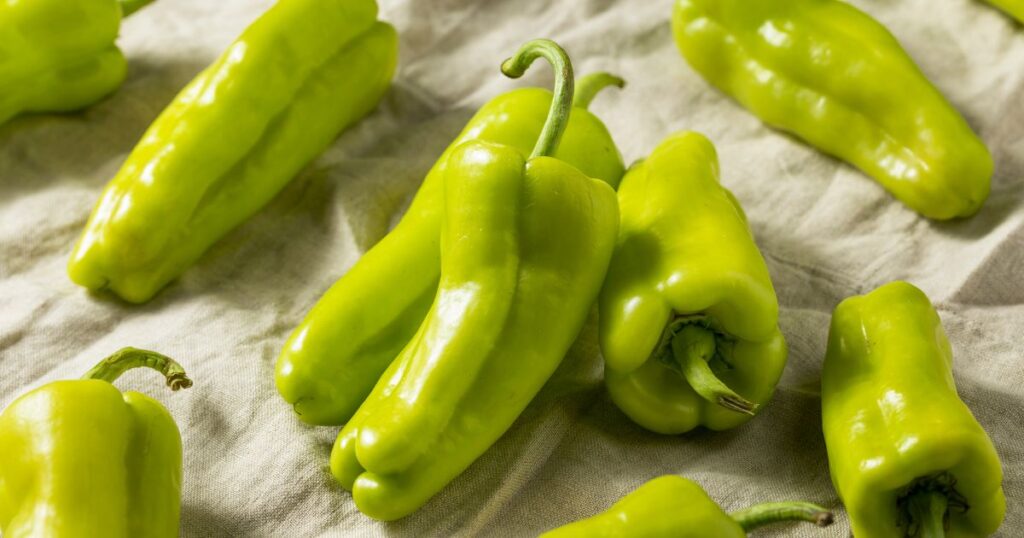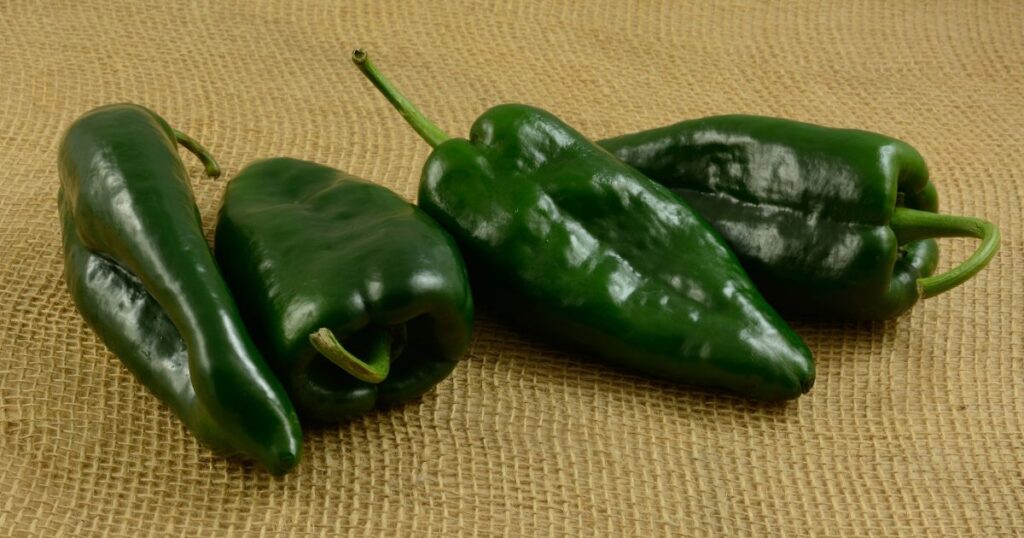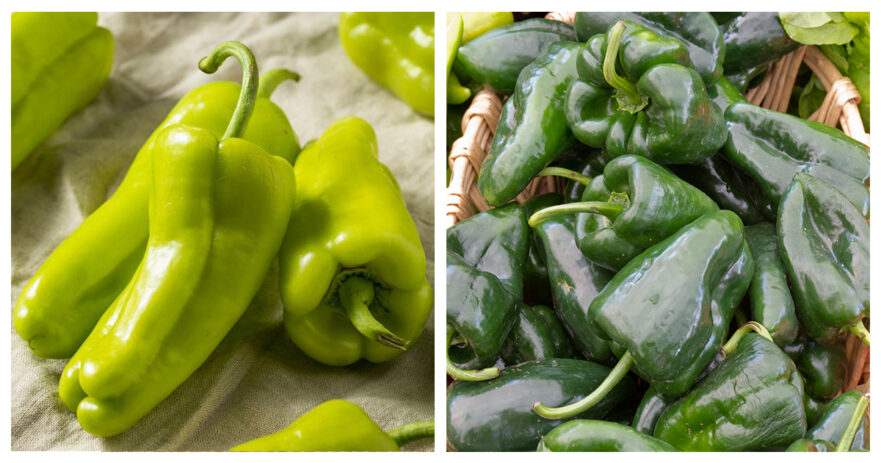In the world of peppers, each variety has a unique blend of heat, flavor, and culinary potential that shines in its own right. Today, we spotlight two beloved varieties, the Cubanelle and Poblano. These peppers have a devoted following among spice enthusiasts and chefs alike due to their flavor and versatile applications. Let’s dive into the distinctive features of cubanelle vs poblano peppers, analyzing their heat, flavor, and culinary uses.
| Cubanelle pepper | Poblano pepper | |
| SHU | 100 - 1,000 | 1,000 - 1,500 |
| Median SHU | 550 | 1,250 |
| Flavor | Mild and sweet, with a slight heat | Mild, rich and earthy flavor |
| Species | Capsicum annuum | Capsicum annuum |
| Origin | South and Central America, but commonly grown in Italy too | Mexico |
| Uses | Salads, stir-fries, stuffing, sandwiches, etc. | Stuffed, roasted, sauces |
Table of contents
What is Cubanelle Pepper?

Known for its sweet and mild flavor, the Cubanelle pepper, also called the Cuban pepper, is a favorite in Caribbean and Latin American cooking. This pepper is slender, slightly curved, and bright green to red or yellow when ripe. It’s not the pepper you reach for when you want a fiery kick; its heat ranges only from 100 to 1,000 Scoville Heat Units (SHU).
Cubanelle’s real charm lies in its rich, sweet flavor, making it a star in salads, casseroles, and stuffed peppers. It’s also a prime candidate for frying – its sweet and tangy flavor balances beautifully when crisped from frying.
Despite its mild heat, the Cubanelle pepper is not bland. Its sweetness carries a distinctive earthy undertone when cooked, providing a depth of flavor that complements various dishes. Whether sautéed in a stir-fry, diced into a salsa, or simmered in a slow-cooked stew, the Cubanelle infuses dishes with a subtle, yet irresistible, touch of sweet spice.
Growing Cubanelle peppers at home is an achievable task. These peppers are notably generous producers, rewarding the home gardener with a plentiful harvest.
They love sunlight and warmth; their vibrant colors give any garden a charming glow.
What is Poblano Pepper?

The Poblano pepper, with its broader, heart-like shape and dark green color, is a staple in Mexican cuisine. It’s slightly hotter than the Cubanelle, with a Scoville rating of 1,000 to 1,500 SHU.
Like Cubanelle, Poblano peppers are prized more for their flavor than heat. They carry a rich, earthy taste with a subtle hint of bitterness, perfect for dishes needing depth and character. Poblanos are often stuffed with cheese or meat for ‚chiles rellenos,‘ roasted for salsas, or dried and ground into powder for mole sauce.
Poblano peppers are used for more than spicy dishes alone. Their mild heat and robust, earthy flavor is an unexpected but delightful addition to less traditional pepper dishes. Try chopping them up for salads or stir-fries, adding them to your morning omelet, or grilling them for a smoky appetizer.
Poblanos become ancho chilies when dried, adding a rich, smoky depth to sauces, marinades, and rubs.
You’re in luck if you want to grow Poblano peppers in your backyard. These plants thrive in full sun and yield a healthy crop of delicious peppers to spice up your meals.
What are the similarities between Cubanelle and Poblano peppers?
The most apparent similarity between Cubanelle and Poblano peppers is their mild heat. They’re both pleasantly warm without being overpoweringly hot, making them excellent choices for those preferring flavor over heat.
Both are fantastic stuffing peppers, given their size and relatively thick walls. Stuffed Cubanelle or Poblano peppers make an impressive main course at any dinner party!
Additionally, Cubanelle and Poblano peppers are both versatile. They’re equally delightful raw in salads, roasted, or fried. And yes, they’re both rewarding to grow at home, thriving in similar growing conditions.
Furthermore, Cubanelle and Poblano peppers provide a vibrant, colorful addition to any dish. These peppers make culinary creations visually appealing, whether it’s the lively green of a fresh Poblano or the bright yellow or red of a ripe Cubanelle.
Their vibrant colors reflect the rich flavors they carry, making your dishes both taste and look good. This visual appeal elevates your cooking, making these peppers a go-to for those who love creating vibrant and flavorful dishes.
What are the differences between Cubanelle and Poblano peppers?
The primary difference between Cubanelle and Poblano peppers lies in their flavor. While Cubanelle peppers are sweet and slightly tangy, Poblano peppers have a deeper, earthier flavor with a hint of bitterness.
They also differ in their shapes. Cubanelle peppers are slender and slightly curved, while Poblano peppers are wider and heart-shaped.
Another difference lies in their culinary origins and applications. Cubanelle peppers, deeply embedded in Caribbean and Latin American cuisines, are used in dishes that benefit from their sweet and tangy flavor, such as casseroles and salads.
On the other hand, Poblano peppers, with their robust and earthy taste, are integral to Mexican cuisine. They’re the star of traditional dishes like ‘chiles rellenos’ and provide a rich base for mole sauces. This distinction guides you in choosing the right pepper for your dish, depending on your desired flavor and cultural authenticity.
Which Pepper Should You Choose?
Choosing between Cubanelle and Poblano depends on your taste preference and the dish you’re preparing. For a sweet and tangy touch to salads or a crispy fried side, reach for the Cubanelle. If you’re after an earthy, rich flavor for depth in your sauces or stuffing, the Poblano is your pepper.
When handling and cooking these peppers, respect their mild heat. While they may not be as fiery as other varieties, they can add a surprising kick!
FAQ about Cubanelle and Poblano
Which dishes are best suited for Cubanelle peppers?
Cubanelle peppers shine in Caribbean and Latin American cuisine, particularly salads, and casseroles, where their unique sweet tanginess shines. Their firm structure makes them ideal for stuffing with meat or cheese. They're also perfect for frying, where the crisp exterior beautifully contrasts their tender, flavorful flesh.
How can I use Poblano peppers in cooking?
Poblano peppers are a cornerstone of Mexican cuisine due to their rich, earthy flavor and gentle heat. A classic application is 'chiles rellenos' - the peppers are hollowed, stuffed with cheese or meat, and fried. Roasting Poblano peppers brings out their flavor and sweetness, making them a fantastic addition to salsas, soups, or enchiladas.
Drying Poblano peppers transforms them into Ancho chilies, which can be ground into a powder. Anchos are critical ingredients in mole sauce, offering a deep, complex flavor. Poblanos also work great on the grill, in pasta, or diced into cornbread for a subtle kick.
Are Cubanelle and Poblano peppers hot?
Both Cubanelle and Poblano peppers are on the milder side of the chili pepper heat spectrum. Cubanelle peppers are known for their low heat, registering a gentle 100 to 1,000 Scoville Heat Units (SHU). They are less spicy than Jalapeños, which have 2,500 to 8,000 SHU. Poblano peppers bring more heat, ranging from 1,000 to 1,500 SHU, but well below many hot pepper varieties. Therefore, these peppers provide a flavorful experience without the intense heat of hotter varieties.
Can I substitute Cubanelle for Poblano peppers in recipes?
Yes, you can substitute Cubanelle for Poblano peppers, and vice versa, as they share a similar heat. However, their flavor profiles are slightly different. Cubanelle peppers have a sweet and slightly tangy flavor, while Poblano peppers offer a deeper, earthier taste.
Can I grow Cubanelle and Poblano peppers at home?
Yes, Cubanelle and Poblano peppers can be grown at home. They need ample sunlight and well-drained soil. Whether in a garden or pots, with proper care—consistent watering and occasional fertilizing—you'll enjoy a bountiful harvest of these delicious peppers, adding fresh, homegrown flavor to your dishes.

